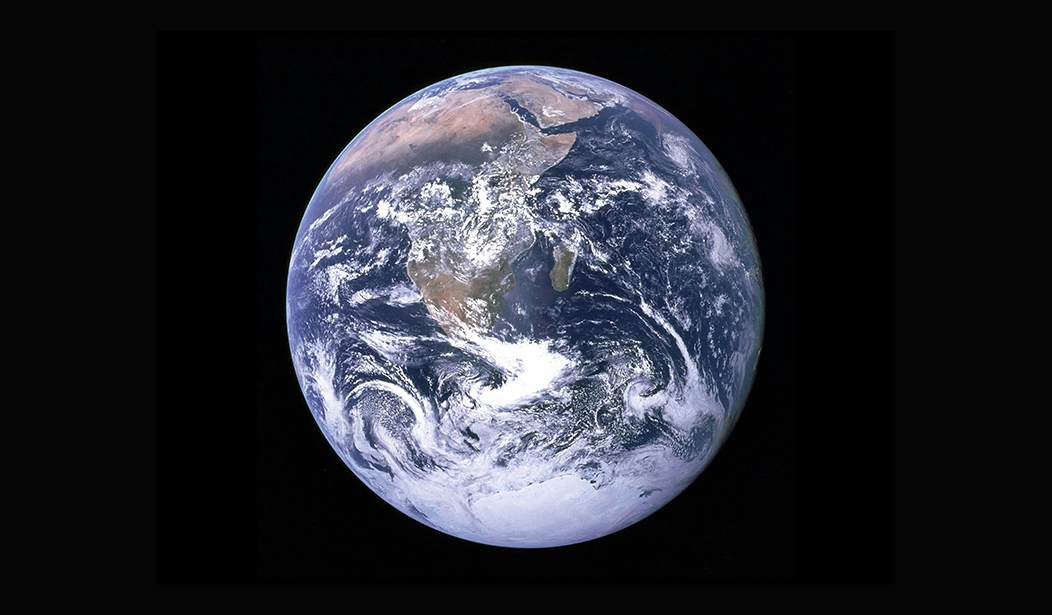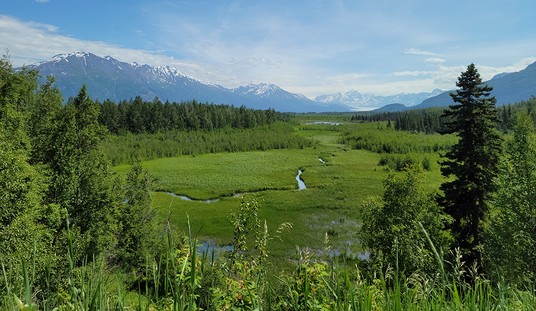I remember a day when I was working a gig in southern California; I was in the area over a weekend, so I decided to take a drive north to see the great redwoods in the Sequoia National Park. I drove up a winding road, and suddenly came around the corner to see several of these massive, unbelievable trees. I had to stop the car, get out, and walk over to one. I put my hand on it, and looked up, up, up, and still couldn't see the tree's crown. That wasn't even one of the largest of those magnificent trees, but it was vast enough to challenge my faith in my own eyes, which were in much better fettle than they are today.
Nature and nature's systems are like that; frequently vast beyond our capability to easily understand or even accept. Nowhere is that more true than in our planet's climate, a vast, chaotic system, which we cannot completely understand, and compared to which any model we can dream up is laughably crude. But there are systems within the climate that we do understand fairly well, and which we never hear the climate scolds discuss.
One of my favorite climate sites is Watts Up With That, and they have a series called "Climate Oscillations" that describes five such systems. Let's take a quick look at each. Note: The oft-mentioned HadCRUT5:
...is one of the main datasets used to monitor global and regional surface temperature variability and trends.
Climate Oscillations 1: The Regression
This is an introduction to the series, and includes some musing by author Andy May on some previous work on climate systems, and how they debunk some of the claims of the scolds:
My last two posts, Musings on the AMO and The Bray Solar Cycle and AMO were fun to research and write, and they helped show that solar variations and cycles do have an impact on climate change regardless of what the IPCC says in AR6 WGI and their other reports.
From AR6 WGI Chapter 7:
“Changes in solar and volcanic activity are assessed to have together contributed a small change of –0.02 [–0.06 to +0.02] °C since 1750 (medium confidence).” (IPCC, 2021, p. 962)
They go on to say that the solar impact on global warming since 1750AD is negative (-0.01°C ± ~0.04°C) (IPCC, 2021, p. 961). They also admit that the ocean oscillations, like the AMO and PDO (which they rename AMV and PDV) are “unpredictable,” (IPCC, 2021, p. 197) meaning they are not reproduced by their models. They try to use this model failure to justify their conclusion that the oscillations are not a natural phenomenon but are simply random natural variability. This is despite statistical evidence that the oscillations are coherent and anything but random.
That's the beginning. From there, the series goes into an examination of the five subsystems that the Intergovernmental Panel on Climate Change (IPCC) thinks don't affect the climate.
The Western Hemisphere Warm Pool (WHWP)
This is a warm area in both the Atlantic and Pacific oceans that rises in the summer and fades in the winter, every year, in a fairly predictable oscillation. Mr. Andy May summarizes:
Although the WHWP is not discussed as much as the AMO, PDO, ENSO, and other oscillations it is a good predictor of the HadCRUT5 global mean surface temperature. In combination with the Antarctic Oscillation or Southern Annular Mode and the AMO it does a very good job. This suggests that The North Atlantic and the Southern Hemisphere circulation patterns correlate very well with global climate trends, CO2 may fit in there somewhere, but it must share the spotlight with these natural oscillations.
Northern Hemisphere Sea Ice Area
Sea ice, of course, is that which Al Gore previously warned us of its disappearance. That hasn't happened, and data instead supports its growth and receding as, yes, you guessed it - a natural oscillation:
Northern Hemisphere sea ice area is an important climatic indicator because it determines how much of the Arctic Ocean and surrounding seas are open to the atmosphere. Ice is a good insulator and traps heat in the water below it (Peixoto & Oort, 1992, p. 361). Ice is also a good reflector of sunlight (high albedo), whereas water is a good absorber (low albedo). While we have no accurate data on Northern Hemisphere sea ice area (called NH_ice here) before 1978, the first year of good satellite data, it does appear to follow the global 60-70-year global climate oscillation (Wyatt, 2020). This may be because the closely related AMO affects the sea ice area as it warms and cools, of course the reverse could also be true.
The Length of Day (LOD)
Believe it or not, the timing of Earth's rotation is not constant. Like most natural systems, it operates within a range, and the exact measurement, the differences of which are too small for us to notice. Nevertheless, it has an impact on things like the jet stream, which in turn can influence weather. Remember last winter's polar vortex?
Longer periods (>10 years) of acceleration in Earth’s rotation speed (shorter LOD) correspond to years of increasing zonal (east-west) circulation and global warming, whereas periods of deceleration (longer LOD) indicate less zonal acceleration and periods of cooling (Lambeck & Cazenave, 1976).
Currently, the variations in the length of day (LOD) are determined by the International Earth Rotation Service (IERS) as the current length of day minus 86,400 seconds (i.e. 24 hours). This difference is very close to zero on 1 January 1958. Annual changes in LOD are almost entirely due to seasonal changes in zonal circulation with tidal, oceanographic, and hydrological phenomena contributing less than 10% to the changes (Lambeck & Hopgood, 1981). At longer timeframes, tides and core-mantle interactions may play a large role in LOD variations. While there is an identifiable tidal influence on LOD, the core-mantle interactions and magnetic field fluctuation effects on LOD are speculative and subjects of debate (Lambeck & Cazenave, 1976).
The Southern Annular Mode or SAM
This has to do with the winds that circle the southern hemisphere, most specifically nearer Antarctica; these winds contain much of the chill of that southernmost continent.
When the SAM is positive in winter the persistent westerly winds and the Southern Ocean current that surround Antarctica intensify and allow less Antarctic cold air to escape to the mid-latitudes. The mid-latitude areas, mainly Patagonia, New Zealand, and Southern Australia warm as a result and often become drier. However, in the summer a positive SAM can also draw tropical moisture south causing northern and eastern Australia to get more precipitation. The effects of SAM on the southern mid-latitudes are dependent upon the season and the effects are often opposite in summer and winter. A negative SAM, during the summer, can cause heatwaves in Southern Australia.
And, finally:
Atlantic Meridional Mode (AMM)
This is an Atlantic phenomenon, and it seems the Atlantic plays a large role in moderating the global mean surface temperature, both in warming and cooling cycles.
The AMM region overlaps with the AMO and WHWP regions. The fact that these three oscillations are among the top six that correlate well with HadCRUT5, and together they explain 74% of the variability in HadCRUT5, either means the Atlantic region is very important in determining the global mean surface temperature (GMST) or the measurements of global surface temperature are biased toward the North Atlantic. I suppose both are possible. Figure 1 shows the best regression of the three Atlantic oscillations (AMO, WHWP, and AMM) against HadCRUT5.
Here's the best bit: As required when one is doing actual science, Andy May offers his bibliography here, and his raw data and code here.
See Also: The Midwest Is Thriving Under Moderate Warming
Run, the Sky Is Falling! DoD Ends Satellite Data-Sharing on Weather, and the Left Has a Freakout
If you have time, there's a lot of material there; read all six reports. They will equip you with a lot of knowledge with which to counter any climate scolds you might encounter, and besides, I've always been a firm proponent of the notion that you can never know too much about anything.
Not only is this series a brilliant explanation of how to do a comprehensive review of data - something the shouting, gesticulating climate scolds never do and never even consider - it's also a great perspective. These are five systems, and Andy May mentions many more such systems. All of these systems influence our climate; all are subject to human influences, but not to the world-wrecking degree that the scolds claim. Our planet's natural rhythms are vast, chaotic, and beyond our capacity to model or easily understand. We can evaluate portions of it, as Andy May has done in this research, but take note of the tentative language. That's because science is supposed to be tentative. It's also because we're still working to understand the full implications of the data. This kind of work puts us a long step forward, but we still have a long, long way to go before we can claim to understand all of the influences on our planet's climate. The great irony, of course, is that the more work is done, the more it refutes the claims of the climate scolds.
Like the giant redwoods, the climate is hard to comprehend, even with your hands on it, as it were. Research like this really hammers that home - and lends even more strength to the argument against reducing our energy-hungry, modern lifestyles in the name of natural systems we do not yet fully understand.














